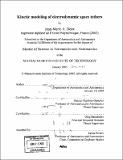Kinetic modeling of electrodynamic space tethers
Author(s)
Deux, Jean-Marie A
DownloadFull printable version (18.22Mb)
Other Contributors
Massachusetts Institute of Technology. Dept. of Aeronautics and Astronautics.
Advisor
Manuel Martínez-Sanchez and Oleg Batishchev.
Terms of use
Metadata
Show full item recordAbstract
Electrodynamic space tethers provide propellant-less orbit boosting and de-orbiting of Low Earth Orbit (LEO) satellites. On the one hand, when driven by a current, their interaction with the Earth's magnetic field creates a thrusting Lorentz force. On the other hand, current can be collected from the ionospheric electrons, which also creates a drag. Although the principle is simple, one theoretical issue still has to be addressed: How much current is collected in realistic LEO conditions by a tether of a given section and potential ? The current theories of current collection fail to explain in-space experimental results and previous kinetic modeling was limited from the computational and physical standpoints: wake partly outside the simulation domain, artificial ion/electron mass ratios, single tether, etc. In the present work we improve our computational techniques and physical model to simulate the tether interaction with the ionosphere. We built a full PIC code which allows to study realistic configurations with the 3V modelling of plasma-probe interactions in external and self-induced magnetic fields. The model uses real electron-ion mass ratio and can simulate domains larger than the wake created in a flowing plasma, thanks to the implementation of a Fast Poisson Solver. Multiwire modelling is available as well to study the interference and efficiency of parallel tether array configurations. The theory of current collection has then been further developed, by showing the existence of electron trapping around the probe, and evaluating the consequences on current collection. This analysis was supported and discussed through several simulations ran with the PIC code. (cont.) We will present results of kinetic studies of current collection for different tether bias, shapes and configurations, including orbit visualizations and statistical diagnostics. Our numerical results will be compared to existing theories of current collection by a moving wire in the OML regime [4]. Eventually, results outside this restricted regime, which are not predicted accurately by any theory, will be discussed.
Description
Thesis (S.M.)--Massachusetts Institute of Technology, Dept. of Aeronautics and Astronautics, 2005. Includes bibliographical references (p. 190-193).
Date issued
2005Department
Massachusetts Institute of Technology. Department of Aeronautics and AstronauticsPublisher
Massachusetts Institute of Technology
Keywords
Aeronautics and Astronautics.